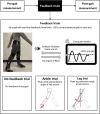Inertial measurement unit-based real-time feedback gait immediately changes gait parameters in older inpatients: a pilot study
- PMID: 39165280
- PMCID: PMC11333335
- DOI: 10.3389/fphys.2024.1384313
Inertial measurement unit-based real-time feedback gait immediately changes gait parameters in older inpatients: a pilot study
Abstract
The effect of gait feedback training for older people remains unclear, and such training methods have not been adapted in clinical settings. This study aimed to examine whether inertial measurement unit (IMU)-based real-time feedback gait for older inpatients immediately changes gait parameters. Seven older inpatients (mean age: 76.0 years) performed three types of 60-s gait trials with real-time feedback in each of the following categories: walking spontaneously (no feedback trial); focused on increasing the ankle plantarflexion angle during late stance (ankle trial); and focused on increasing the leg extension angle, which is defined by the location of the ankle joint relative to the hip joint in the sagittal plane, during late stance (leg trial). Tilt angles and accelerations of the pelvis and lower limb segments were measured using seven IMUs in pre- and post-feedback trials. To examine the immediate effects of IMU-based real-time feedback gait, multiple comparisons of the change in gait parameters were conducted. Real-time feedback increased gait speed, but it did not significantly differ in the control (p = 0.176), ankle (p = 0.237), and leg trials (p = 0.398). Step length was significantly increased after the ankle trial (p = 0.043, r = 0.77: large effect size). Regarding changes in gait kinematics, the leg trial increased leg extension angle compared to the no feedback trial (p = 0.048, r = 0.77: large effect size). IMU-based real-time feedback gait changed gait kinematics immediately, and this suggests the feasibility of a clinical application for overground gait training in older people.
Keywords: clinical application; gait analysis; gait training; propulsion; wearable sensor.
Copyright © 2024 Miyazaki, Kiyama, Takeshita, Shimose, Araki, Matsuura, Uto, Nakashima, Nakai and Kawada.
Conflict of interest statement
The authors declare that the research was conducted in the absence of any commercial or financial relationships that could be construed as a potential conflict of interest.
Figures


Similar articles
-
Examination of effect and responder to real-time auditory feedback during overground gait for stroke: a randomized cross-over study.Sci Rep. 2025 Mar 12;15(1):8519. doi: 10.1038/s41598-025-93262-4. Sci Rep. 2025. PMID: 40074803 Free PMC article. Clinical Trial.
-
Immediate Effects of Real-Time Feedback During Overground Gait Performed Using Inertial Measurement Units on Gait Parameters in Healthy Young Participants: A Cross-Sectional Study.Motor Control. 2023 Jul 24;27(4):844-859. doi: 10.1123/mc.2022-0122. Print 2023 Oct 1. Motor Control. 2023. PMID: 37487588
-
Effect of Leg Extension Angle on Knee Flexion Angle during Swing Phase in Post-Stroke Gait.Medicina (Kaunas). 2021 Nov 9;57(11):1222. doi: 10.3390/medicina57111222. Medicina (Kaunas). 2021. PMID: 34833440 Free PMC article.
-
Contributions to the understanding of gait control.Dan Med J. 2014 Apr;61(4):B4823. Dan Med J. 2014. PMID: 24814597 Review.
-
Wearable inertial sensors provide reliable biomarkers of disease severity in multiple sclerosis: A systematic review and meta-analysis.Ann Phys Rehabil Med. 2020 Mar;63(2):138-147. doi: 10.1016/j.rehab.2019.07.004. Epub 2019 Aug 14. Ann Phys Rehabil Med. 2020. PMID: 31421274
Cited by
-
Examination of effect and responder to real-time auditory feedback during overground gait for stroke: a randomized cross-over study.Sci Rep. 2025 Mar 12;15(1):8519. doi: 10.1038/s41598-025-93262-4. Sci Rep. 2025. PMID: 40074803 Free PMC article. Clinical Trial.
-
The Effects of Real-Time Haptic Feedback on Gait and Cognitive Load in Older Adults.IEEE Trans Neural Syst Rehabil Eng. 2025;33:2335-2344. doi: 10.1109/TNSRE.2025.3578865. IEEE Trans Neural Syst Rehabil Eng. 2025. PMID: 40498599 Free PMC article.
References
-
- Abellan van Kan G., Rolland Y., Andrieu S., Bauer J., Beauchet O., Bonnefoy M., et al. (2009). Gait speed at usual pace as a predictor of adverse outcomes in community-dwelling older people an International Academy on Nutrition and Aging (IANA) Task Force. J. Nutr. Health Aging 13 (10), 881–889. 10.1007/s12603-009-0246-z - DOI - PubMed
-
- Araki S., Matsuura H., Miyazaki T., Matsuzawa Y., Nakai Y., Kawada M., et al. (2024). Longitudinal changes in vertical stride regularity, hip flexion, and knee flexion contribute to the alteration in gait speed during hospitalization for stroke. Hum. Mov. Sci. 95, 103227. 10.1016/j.humov.2024.103227 - DOI - PubMed
LinkOut - more resources
Full Text Sources

